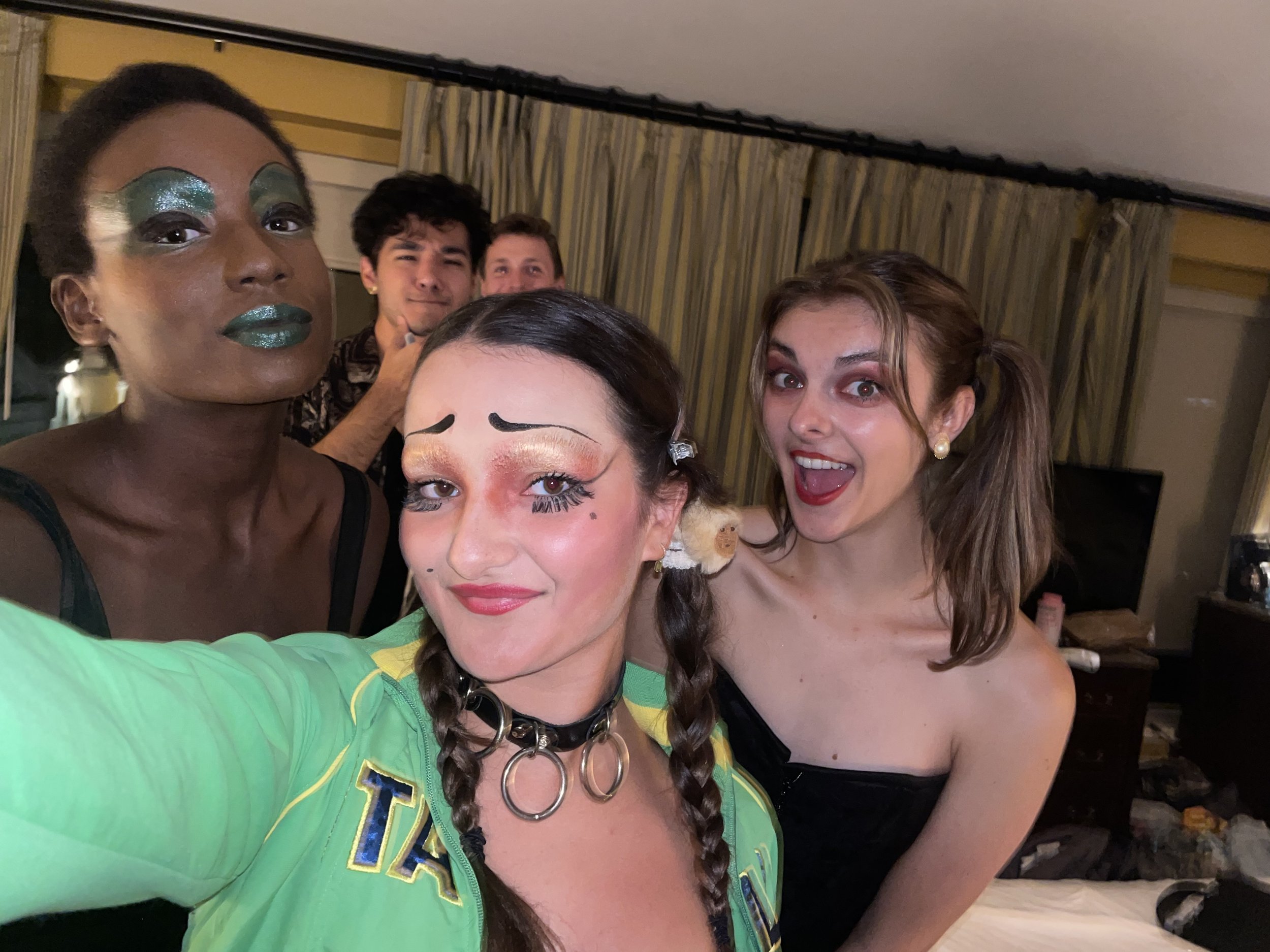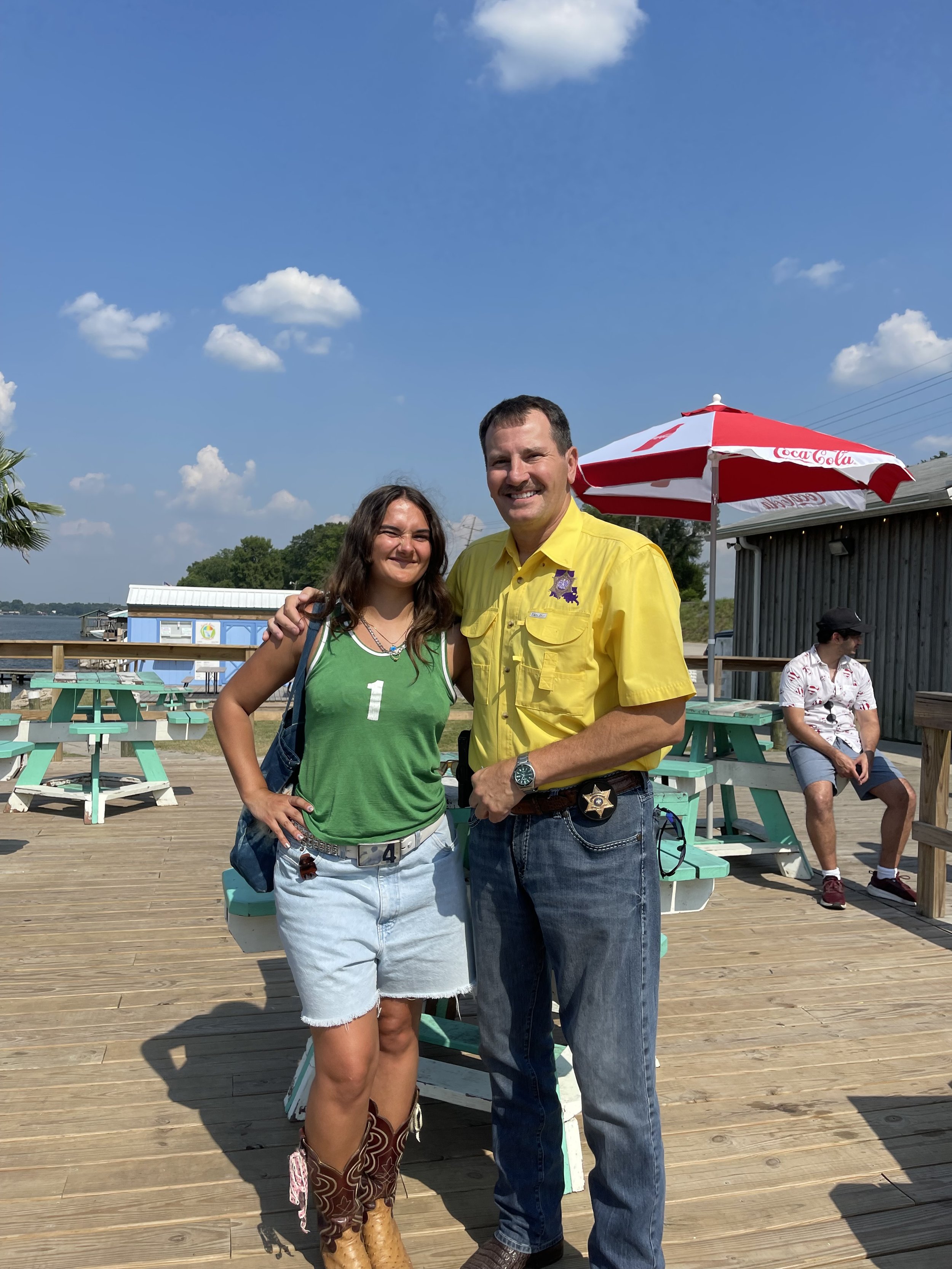The dolls get ready to see Rocky Horror
FRANCESCA
As our group of Bookpackers gathered outside of the Prytania theater, I shivered with antici…………pation, to quote the film and performance we were gathered to see - The Rocky Horror Picture Show. It was all of our first times seeing the movie live, so a cast member came along to mark our faces with large “V”s etched crudely in thick red lipstick. Upon entering the theater, I noticed two figures who stood apart from the joyful freaks of delicious decadence that comprised the general population of the attendees (ourselves included in that description). One was a rather reserved and somewhat plain looking fellow chatting with a movie theater attendant about some smell of some exotic flower, and the other was a large, belching man wearing a green and ear-flapped hunting cap. The latter bloke was accompanied by a lithe beatnik woman - quite the remarkable pair. They sat in the exact center of the theater, while the quiet man sat a bit further back. As we passed by the fat man and his hip girl, we heard him shout, “What incalculable degeneracy is this! The state of this city has utterly decayed…These outfits are an absolute abomination to the principles of theology and geometry!” And with that he stuffed a large mitt of popcorn into his mouth. I could tell that the quiet man was amused by this.
Standing outside of the Prytania in all its glory!
BINX
It was another day of simple satisfaction, as most of my days had been since I settled down with Kate. She was with Aunt Emily this evening and he had decided to see a movie, which he had not done for some time now. My life has been comfortable, pleasant, and wonderful in its new simplicity. After speaking with an old friend (an employee at the theater) I took my seat. I marveled at the Harmony Korinne-ish crowd, gold lamé shorts reminding me of Chloë Sevigny’s shining golden hair. I smiled at a big man with a worn green cap, and only after he passed did I realize that he had entranced me totally and completely. As the lights grew dim, I could not help but see his strangely intoxicating blue and yellow eyes in each painted face of the show’s performer’s.
FRANCESCA
As the show began, we squeezed each other’s hands and giggled in excitement. Our prop kits (provided by the theater) were ready, and so were we. The show includes many actions to be done by the audience along with the film and the live performers. The first of these actions is to throw rice at the screen at the same time that the actors do when two characters get married. Our group gleefully tossed rice ahead of us, behind us, at one another, and I heard a large uproar that seemed less pleasant than the other shrieks in the sonic landscape. Someone had clearly not gotten the memo: the green cap exclaimed “OH, MY GOD! WE ARE UNDER SIEGE! SOMEONE ALERT THE CORRECT AUTHORITIES AT ONCE!” At that, everyone began to throw the rice directly at the poor freak. Such occurrences continued throughout the showing, until he was brought up on stage at the end and thanked by all of the performers. He looked appalled, but his female companion urged him onwards vehemently.
BINX
When that peculiar and captivating presence was forced onto the stage by the circuslike performers, I felt sorry for him. More than this, though, I felt a terribly strange philosophy reemerge in my mind: it was the search. It was back. Something about the soft curl of his cheeks into the bulbous earlobes was impenetrably sensual. I could not explain it, I would not explain it, but when his beatnik girl came up to me and said that she wanted a word, I could not resist. My searchlight relit, I went home with them that night. I haven’t been apart from them a second since.
FRANCESCA (epilogue)
I am back in New Orleans now two years after that first time at the Prytania. I am alone now, but I saw that Rocky Horror was playing again at the Prytania and thought that I might relive some old memories. Some of the cast remained the same, but others had been replaced. After watching the first few acts, the visions before me clicked. I had seen the new cast before! The new Frank N. Furter was that fabulously large man with the blue and yellow eyes, the new Rocky was the quiet man, and that slinky lady with the loud laugh who had been with the men before, well she was the new Magenta! How perfect, how fitting, how right. There is love and debauchery in the air tonight, and I breathe it in readily.
(As a clarification for those who have not read these books, the green hunting cap is Ignatius J. Reilly and his companion is Myrna Minkoff from Confederacy of Dunces, Binx is himself from The Moviegoer. Our group did go see Rocky Horror at the Prytania, though these events are fictionalized as an exercise in imagination. Binx and Ignatius and Myrna are now in a polyamorous and cinephilic relationship. Happy Pride Month!)












